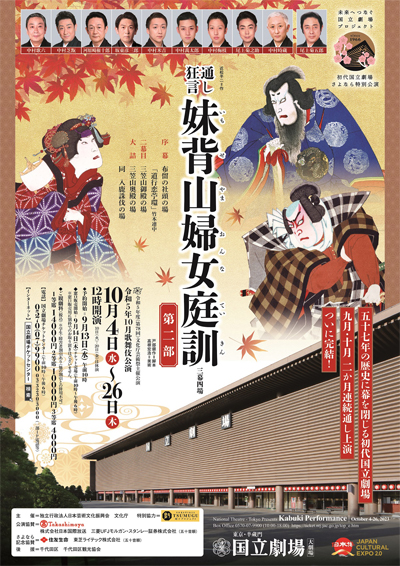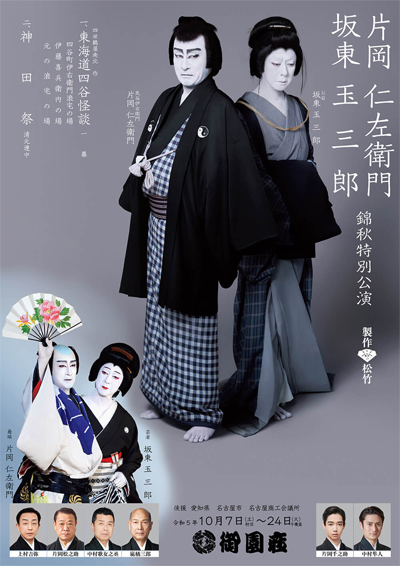| OCTOBER 2023 |
|
4 shows in T˘ky˘ (Kabukiza, National Theatre, Asakusa K˘kaid˘), 1 in Nagoya (Misonoza), 1 in Tachikawa (Tachikawa Stage Garden) and 2 tours (Kinshű Special Tour, Succession Announcement Tour)!
|
| Kabukiza (T˘ky˘) |  |
| Dates | 2 ~ 25 October 2023 Kinshű Jűgatsu ďkabuki Autumn Brocade October Grand Kabuki |
| MatinÚe | |
| Evening |
Futatsu Ch˘ch˘ Kuruwa Nikki (Sum˘ba) Kiku |
| Casting |
Nakamura Kaishun, Nakamura Jakuemon, Onoe Sh˘roku, Kataoka Takatar˘, Nakamura Shid˘, Kataoka Kamez˘, Band˘ Minosuke, Band˘ Yajűr˘, Nakamura Matagor˘, Ichikawa Komaz˘, Nakamura Kikaku, Band˘ Kamez˘, Matsumoto Kingo, Sawamura S˘nosuke, Nakamura Matsue, Band˘ Shingo, Nakamura Kash˘, Nakamura Tanenosuke, ďtani Hirotar˘, Nakamura Kichinoj˘, Nakamura Fukunosuke, Nakamura Utanosuke, Nakamura Toranosuke, Nakamura Tamatar˘, Ichikawa Otora, Ichimura Hikaru, Terajima Shinobu |
| Comments |
The October Grand Kabuki at the Kabukiza.
|
 |
 |
| National Theatre (T˘ky˘) |
| Dates | 4 ~ 26 October 2023 |
| Program |
|
| Casting |
Living National Treasure Onoe Kikugor˘, Nakamura Shikan, Nakamura Tokiz˘, Onoe Kikunosuke, Nakamura Karoku, Band˘ Hikosabur˘, Nakamura Baishi, Nakamura Yonekichi, Nakamura Mantar˘, Kawarasaki Gonjűr˘ |
| Comments |
There will be a 2nd generation National Theatre in a near future! From November 2022 to October 2023, Sayonara K˘en ('Farewell Performances') were staged in the existing theater. Then, the 1st generation National Theatre, which opened in November 1966, will be closed and rebuilt. These farewell performances have been precisely labeled as Mirai e Tsunagu Kokuritsu Gekij˘ Purojekuto ~ Shodai Kokuritsu Gekij˘ Sayonara K˘en (literally 'Project to Connect the National Theater to the Future ~ First generation National Theater Farewell Performances'). In November 1966 [more details] and December 1966 [more details], the opening of the theater was celebrated with a t˘shi ky˘gen production of the classic "Imoseyama Onna Teikin". In September 2023 and October 2023, the closing is celebrated with ... a t˘shi ky˘gen production of the classic "Imoseyama Onna Teikin". Second part of the t˘shi ky˘gen production of the classic "Imoseyama Onna Teikin" with a troupe led by Living National Treasure Onoe Kikugor˘.
|
 |
| Misonoza (Nagoya) |  |
| Dates | 7 ~ 24 October 2023 Kataoka Nizaemon Band˘ Tamasabur˘ Kinshű Tokubetsu K˘en Kataoka Nizaemon Band˘ Tamasabur˘ Autumn Brocade Special Performances |
| Program |
T˘kaid˘ Yotsuya Kaidan |
| Casting |
Living National Treasure Kataoka Nizaemon, Living National Treasure Band˘ Tamasabur˘, Nakamura Hayato, Kamimura Kichiya, Arashi Kitsusabur˘, Nakamura Kamenoj˘, Kataoka Matsunosuke, Kataoka Sennosuke |
| Comments |
No classic October kaomise programs in Nagoya this year but a special Kabuki program starring the goruden konbi Living National Treasures Band˘ Tamasabur˘ and Kataoka Nizaemon.
|
 |
 |
| Succession Announcement Tour | |
| Dates | 13 October ~ 12 November 2023 Jűsandaime Ichikawa Danjűr˘ Hakuen Shűmei Hir˘ Jungy˘ Ichikawa Danjűr˘ XIII Hakuen Succession Announcement Tour |
| Dates | 13 October ~ 12 November 2023 |
| Program | |
| Casting |
Ichikawa Danjűr˘, Ichikawa Udanji, Nakamura Kotar˘, Kataoka Ichiz˘, Ichikawa Kudanji, ďtani Hiromatsu, Nakamura Kangyoku |
| Comments |
A special tour celebrating the shűmei of Ichikawa Danjűr˘ XIII with performances in 20 cities.
|
 |
 |
| Kinshű Special Tour | |
| Dates | 5 ~ 21 October 2023 Kinshű Tokubetsu K˘en Autumn Brocade Special Performances |
| Program |
T˘ku K˘nÔ Kuwana no Ura Otohime to Urashima |
| Casting |
Nakamura Kankur˘, Nakamura Shichinosuke, Nakamura Tsurumatsu |
| Comments |
The word kinshű means "Autumn Brocade". This Autumn tour in 14 cities stars Nakamura Kankur˘ and Nakamura Shichinosuke. The first item in the program, entitled T˘ku K˘nÔ (literally 'Talk Corner') is a speech/presentation on stage about some aspects of Kabuki. |
| Tachikawa Stage Garden (Tachikawa) | |
| Dates | 25 ~ 28 October 2023 Tachikawa Tachihi Kabuki Tokubetsu K˘en Tachikawa Tachihi Kabuki Special Performances |
| Program |
|
| Casting |
Ichikawa Chűsha, Nakamura Kazutar˘, Ichikawa Emisabur˘, Ichikawa Emiya, Ichikawa En'ya, Nakamura Takanosuke, Ichikawa Juen, Ichikawa Seiko, Ichikawa Danko |
| Comments |
A special version of the classic "Yoshitsune Senbon Zakura" focusing on Tadanobu is staged in Tachikawa at the Tachikawa Stage Garden under the supervision of Ichikawa En'˘ to celebrate the coming 100th anniversary of the creation of the Tachihi Group. |
 |
|
|||
| Dates | 6 October 2023 Sh˘ no Kai |
||
| Program |
Tenn˘jiya Gatari (Kich˘ Eij˘) |
||
| Casting |
Nakamura Takanosuke, Nakamura Kotar˘, Ichikawa En'ya, Ichikawa Kudanji, Watanabe Aiko |
||
| Comments |
8th edition of the Sh˘ no Kai, a 1-day 2-performance gala program which stars Nakamura Tomijűr˘ V's son Nakamura Takanosuke. Nakamura Takanosuke's sister Watanabe Aiko also performs in this gala. It will commemorate the 12th anniversary (13th memorial service) of the passing away of Nakamura Tomijűr˘ V. Sources: Earphone Guide Website or Sh˘chiku Kabuki Official Website |
||
 |
|
|
| Contact | Main | Top | Updates | Actors | Plays | Playwrights | Programs | Links | FAQ | Glossary | Chronology | Illustrations | Prints | Characters | Derivatives | Theaters | Coming soon | News |